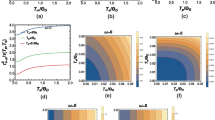A microscopic explanation of the low-frequency kinetic properties of metal oxides is proposed. It is based on a strong electron-phonon interaction, which forms a charged Bose liquid of small bipolarons. The large value, the nonKorringa temperature dependence above T c, and the absence below T c of the coherent peak of the nuclear spin relaxation, as well as an unexpected “coherent peak” of the low frequency dynamic conductivity and the linear T-dependence of the resistivity are explained.
Similar content being viewed by others
References
A. J. Millis, H. Monien, and D. Pines, Phys. Rev. B 42, 167 (1990).
K. Levin, Yu H. Kim, J. P. Lu, and Qimiao Si, Physica C 175, 449 (1991).
T. Brückel, H. Capellmann, W. Just, O. Schärpf, S. Kemmler-Sach, R. Kiemel, and W. Schaefer, Europhys. Lett. 4, 1189 (1987).
J. Rossat-Mignod, L. P. Regnault, C. Vettier, P. Burlet, J. Y. Henry, and G. Lapertot, Invited paper presented at the “VIe International School in Neutron Physics”, Alushta, URSS, October 8–18 (1990); Physica B 169, 58 (1991).
C. M. Varma, P. B. Littlewood, S. Schmitt-Rink, E. Abrahams, and A. E. Ruckenstein, Phys. Rev. Lett. 63, 1996 (1989).
T.Machi, I. Tomeno, T. Miyatake, N. Koshizuka, and S. Tanaka, Physica C 173, 32 (1991).
D. Brinkmann, in Progress in High Temperature Superconductivity, V. L.Aksenov, N. N. Bogolubov, and N. M. Plakida, eds. (World Scientific, Singapore 1989), vol. 21, p. 230; G. Shirane, ibid, p. 63; W. W. Warren Jr., R. E. Walstedt, G. F. Brennert, R. J. Cava, R. Tyeko, R. F. Bell, and G. Dabbagh, Phys. Rev. Lett. 62, 1193 (1989).
Martin, C., C. Nuss, P. M. Maukiewich, M. L. O'Malley, and E. H. Westerwick, Phys. Rev. Lett. 66, 3305 (1991).
K. Holczer, L. Forro, L.Mihály, and G. Grüner, Phys. Rev. Lett. 67, 152 (1991).
A. Alexandrov and J. Ranninger, Phys. Rev. B 23, 1796 (1981); Phys. Rev. B 24, 1164 (1981).
A. S. Alexandrov and V. V. Kabanov, Fiz. Tverd. Tela 28, 1129 (1986) (Sov. Phys. Solid State 28, 631 (1986)).
S. Lakkis, C. Schlenker, V. K. Chakraverty, and R.Buder, Phys. Rev. B 14, 1429 (1976); C. Schlenker, S. Ahmed, R. Buder, and M. Gourmala, J. Phys. C, 12, 3503 (1979); V. K. Chakraverty, M. J. Sienko, and J. Bonnerot, Phys. Rev. B 17, 3781 (1978).
A. S. Alexadrov and A. B. Krebs, Pis'ma Zh. Eksp. Teor. Fiz. 50, 280 (1989) (Sov. Phys.-JETP Lett. 50, 311 (1989)); A. S. Alexnadrov, H. Capellmann, Phys. Rev. B 43, 2042 (1991).
H. de Raedt and A. Lagendijk, Z. Phys. B 65, 43 (1986).
F. Mila and T. M. Rice, Physica C 157, 561 (1989); Phys. Rev. B 40, 11382 (1989).
L. J. de Jongh, Physica C 152, 171 (1988).
A. S. Alexandrov, Physica C 191, 115 (1992).
A. S. Alexandrov and J. Ranninger, Physica C 159, 367 (1989).
N. Mott, Adv. in Phys. 39, 55 (1990).
P. W. Anderson, Science 235, 1196 (1987).
The argument against the bosonic (charge e) nature of the linear T-dependence of the resistivity appeared in literature (see J. Z. Wu, C. S. Ting, D. Y. Xing, Phys. Rev. B 40, 9296 (1989), and also W. Pint, E. Schachinger, Phys. Rev. B 43, 7664 (1991)), and is based on the random-phase approximation for the Coulomb scattering, which gives an infinitely large static dielectric constant for T → 0 in case of bosons. However, the screaning radius is restricted by the lattice constant, and for the short-range impurity potential both the fermionic and bosonic impurity resistivity is the same. Thus the argument by Wu et al. seems to be irrelevant.
C. Taliani, E. Zambone, G. Raum, F. C. Matacotta and K. I. Pokhodnya, Solid State Commun. 66, 487 (1988); D. M. Foster, A. J. Heeger, G. Stacky, and N. Herron, Solid State Commun. 71, 945 (1989).
Author information
Authors and Affiliations
Rights and permissions
About this article
Cite this article
Alexandrov, A.S. Low-frequency kinetics of high-T c metal oxides. J Low Temp Phys 87, 721–729 (1992). https://doi.org/10.1007/BF00118331
Received:
Revised:
Issue Date:
DOI: https://doi.org/10.1007/BF00118331




